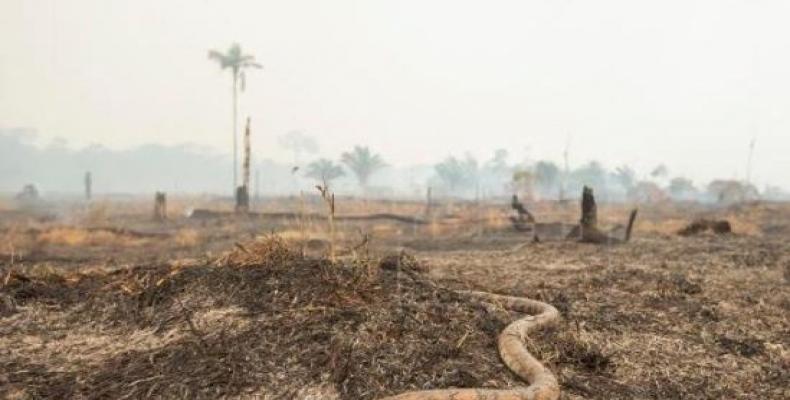Brasilia, April 19 (RHC)-- Deforestation, fires, land invasions, and now the coronavirus - Indigenous people in the Brazilian Amazon are isolating themselves from the pandemic in remote jungle areas to dodge a health crisis that has already claimed its first lives in their communities.
“The situation is quite complicated,” Paulo Tupiniquim, one of the coordinators of the Association of Indigenous People of Brazil, told EFE.
At least three members of Indigenous groups have reportedly died of COVID-19 in Brazil, whose borders contain roughly two-thirds of the Amazon basin, including a 15-year-old member of the Yanomami ethnic group.
There have been 17 confirmed coronavirus cases and 22 other suspected cases among the indigenous population, according to the federal Health Ministry’s latest bulletin, although civil society organizations and authorities consulted by EFE say those numbers are likely higher. Coronavirus cases also have been detected in the Amazon regions of Colombia and Peru.
In addition to this new threat from an “invisible enemy,” as some ethnic groups refer to COVID-19, illegal loggers and miners also have been capitalizing on reduced oversight during the pandemic to step up their invasions of Indigenous lands.
Native peoples are the most vulnerable to new diseases, as history has shown. Before Portuguese explorer Pedro Alvares Cabral set foot in 1500 in what today is Brazil, that territory’s Indigenous population was estimated at around 3 million.
Less than a century later, more than half of that population - 1.8 million - had disappeared. Wars, slavery, and European-introduced diseases for which indigenous people lacked antibodies caused their numbers to decline drastically.
Concerns about the survival of some ethnic groups are particularly acute, particularly the Karipuna in the western state of Rondonia, which borders Bolivia. That tribe is believed to consist of just 58 people and has seen its lands systematically invaded by illegal loggers.
Also under threat are members of the Yanomami tribe living in uncontacted villages on the border with Venezuela; the Zuruaha, whose population is less than 200; and the Indigenous people of the Javari Valley, a territory in Amazonas state, near the Peruvian border, that is home to the world’s largest concentration of isolated native peoples.
The situation in Amazonas state, home to Brazil’s largest Indigenous population (168,700, according to the latest census in 2010), is among the most serious nationwide with 1,554 confirmed coronavirus cases and 106 COVID-19-related deaths - more than 5 percent of the country’s total in each category - in just one month.
Nationwide, Brazil has had around 30,000 confirmed coronavirus cases and 1,736 COVID-19-related deaths, and the peak of the pandemic in that country is not expected to arrive until May or June.
Amazon monitoring agencies, meanwhile, have been less active during the pandemic, and logging and mining mafias operating in the region have taken advantage of that reduced scrutiny to intensify their aggression.
Alessandra Korap, the 36-year-old leader of the Munduruku ethnic group, is used to living under a constant state of threat on the Praia do Indio indigenous reserve in the northern state of Para. “The enemy comes from all sides. The enemy of wood, the enemy of mineral resources, the enemy of the virus, and it’s very worrying,” she told EFE.
Korap said these criminal gangs have long brought violence to their ancestral lands but now may be carriers of the virus and cause it to spread within indigenous populations. “They haven’t quarantined. They’re still active,” Cerqueira said.
The numbers tell the story of a rapid increase in indiscriminate logging in the Amazon. Deforestation in the first quarter of 2020 was the highest of the past five years and up 51.4 percent from the same three-month period of 2019. In March, as the coronavirus was expanding throughout Brazil, deforestation rose by 30 percent.
Violence against indigenous people also has continued unabated, with the shooting death of a Guajajara Indigenous leader on March 31 in the northeastern state of Maranhao marking the fifth such murder of a member of that ethnic group over the past five months.


